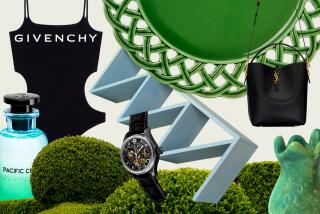WHERE THERE’S NO SMOKE : A Fixture of the Tobacco Age, the Ashtray Has Gone the Way of the Dinosaur
- Share via
In spite of periodic housecleanings on the order of the sacking of Rome, I still can’t part with the most vestigial objects I own: ashtrays.
Nobody smokes in my house. Nobody. My own mother, who has smoked since they were called Lucky Strike Greens, knows that she and her noxious weed must commune outside.
But I always have an ashtray for her; at least I am that polite a hostess. Which one will it be? The oblong one from the Turquoise Room of the old Super Chief, when trains had restaurants worthy of their own ashtrays? How about the silver-dollar-sized one from the Lame Duck Motel in Selma on Highway 99, once the mother road of the Central Valley? Maybe the bubble-like one showing the chic clientele of the defunct Nikabob cafe at Western and 9th, “finest foods since 1928.”
Instead of all the ersatz Hollywood memorabilia that gets shoved into our hands--whoever really met the Flintstones?--why not appreciate objects that once had utility, even meaning?
I never boarded the Super Chief, never stayed at the Lame Duck Motel, never ate at Nikabob; yet my ashtrays conjure these vanished places. A Northridge woman recently paid $1,100 for a black ceramic ashtray from an office at Graceland; if she just wanted to keep the bridge club from putting out their cigarettes in the planter, she could have saved herself $1,099 and the trip to the Elvis auction.
I have a photo of my parents on their honeymoon. They are at Jack Dempsey’s bar in New York City, looking young and terrified, and they are tapping the ash of their cigarettes into what is very likely a souvenir ashtray. If they swiped it, they never let on. Everyone swiped ashtrays. It was expected; ashtrays were a marketing ploy, keeping the hotel or restaurant name in front of you, suggesting the establishment’s merits every time you lighted up.
But when was the last time you saw an ashtray worth swiping? Not the bland glass squares you see these days (someone with whimsy and nerve could make a pile manufacturing ashtrays with skulls and crossbones on them), but pink Depression-glass boudoir ashtrays, big ceramic bowling-alley ashtrays, ashtrays from the Normandie, from Pan Am (yes, mijos, people used to smoke on airplanes).
Ed Gein, the original “Psycho” killer whom even Hitchcock had to tone down, made ashtrays out of the joints of bodies he dug up from the cemetery--a true memento mori.
Politicians scattered them like . . . I was about to say Pentagon contracts, but that’s no longer the case. . . . like invitations to fund-raisers, which may be the provenance of two of my ashtrays:
One is an oval smoked-glass number bearing the seal of Los Angeles and the signature of Mayor Sam Yorty. The other is shaped like a cowboy hat, its 10-gallon crease big enough for a cigar. On the brim are the seal and signature of President Lyndon B. Johnson. The ‘60s were a Golden Age for smokers and politicians alike.
Ashtrays were what kids made for their parents in crafts class because nobody was anywhere near good enough to make a soup tureen. Ashtrays were where movie spies dropped incriminating microfilm and burned it to a cinder just as they got shot.
Ashtrays were the gifts brought back from vacation, the haul from a panicked boarding-call spree through the airport gift shop. They were the souvenir T-shirts of their age, useful but expendable, subtly recalling some pleasant location or event. Smoke won’t be missed, but ashtrays will hang in the limbo of remembered irrelevance, the way we still say “dial” a phone when we mean “push the buttons.”
A smokeless ashtray was among the objets sealed into a City Hall time capsule last year. What will they make of it 99 years hence? I’ll tell you: People will wonder what the fuss over Bill Clinton was all about; in 99 years, nobody will be inhaling.
More to Read
Eat your way across L.A.
Get our weekly Tasting Notes newsletter for reviews, news and more.
You may occasionally receive promotional content from the Los Angeles Times.











